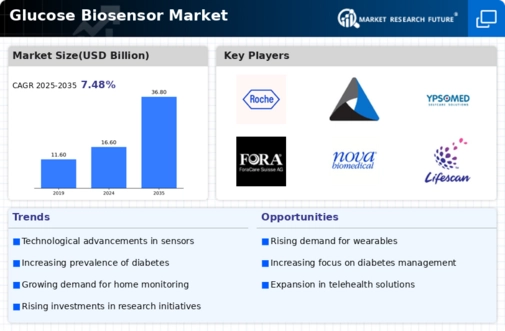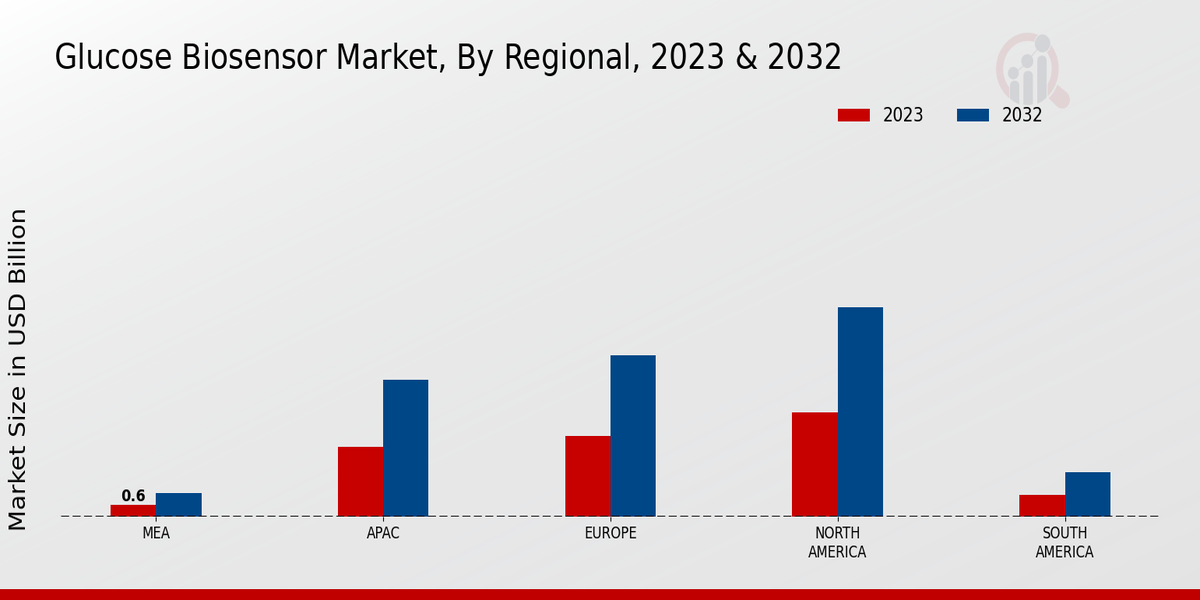Market Growth Projections
The Global Glucose Biosensor Market Industry is projected to experience substantial growth in the coming years. With a market value of 16.6 USD Billion in 2024, it is anticipated to reach 36.8 USD Billion by 2035, indicating a robust expansion trajectory. The compound annual growth rate (CAGR) of 7.48% from 2025 to 2035 further underscores the increasing demand for glucose monitoring solutions. This growth is driven by various factors, including technological advancements, rising diabetes prevalence, and heightened health awareness. The market's expansion reflects the critical role of glucose biosensors in managing diabetes effectively and improving patient outcomes.
Rising Prevalence of Diabetes
The increasing prevalence of diabetes globally is a primary driver for the Global Glucose Biosensor Market Industry. As of 2024, approximately 537 million adults are estimated to be living with diabetes, a number projected to rise significantly in the coming years. This surge in diabetic patients necessitates effective glucose monitoring solutions, thereby propelling the demand for glucose biosensors. The market is expected to reach 16.6 USD Billion in 2024, reflecting the urgent need for innovative monitoring technologies. The Global Glucose Biosensor Market Industry is thus positioned to expand rapidly, catering to a growing population that requires constant glucose level management.
Integration of Smart Technologies
The integration of smart technologies into glucose monitoring devices is reshaping the Global Glucose Biosensor Market Industry. The advent of wearable devices and mobile applications that sync with glucose biosensors is enhancing user experience and data accessibility. These technologies allow for real-time monitoring and data sharing with healthcare providers, facilitating better management of diabetes. As consumers seek more connected and user-friendly solutions, the demand for smart glucose biosensors is expected to rise. This trend aligns with the overall market growth, as innovations in technology continue to drive advancements in biosensor capabilities and functionalities.
Government Initiatives and Support
Government initiatives aimed at improving diabetes care and management are driving the Global Glucose Biosensor Market Industry. Various health organizations and government bodies are implementing programs to promote awareness and accessibility of diabetes management tools, including glucose biosensors. For instance, funding for research and development in diabetes technologies is increasing, which is likely to foster innovation in the biosensor sector. Such initiatives not only enhance the availability of glucose monitoring devices but also encourage manufacturers to invest in developing advanced biosensor technologies. This supportive environment is expected to contribute to a robust market growth trajectory in the coming years.
Technological Advancements in Biosensors
Technological advancements in biosensor technology are significantly influencing the Global Glucose Biosensor Market Industry. Innovations such as continuous glucose monitoring systems and non-invasive glucose sensors are enhancing the accuracy and convenience of glucose monitoring. These advancements not only improve patient compliance but also broaden the application scope of glucose biosensors in clinical and home settings. As a result, the market is anticipated to grow, with projections indicating a rise to 36.8 USD Billion by 2035. The integration of smart technologies and mobile applications further supports this growth, as they provide real-time data and analytics, thereby enhancing patient management and outcomes.
Growing Health Awareness and Preventive Healthcare
The rising health awareness among consumers regarding diabetes and its management is a crucial driver for the Global Glucose Biosensor Market Industry. As individuals become more informed about the implications of uncontrolled blood sugar levels, there is a growing demand for effective monitoring solutions. Preventive healthcare is gaining traction, with more people opting for regular health check-ups and monitoring their glucose levels proactively. This trend is likely to increase the adoption of glucose biosensors, as they provide essential data for managing health. The market is poised for growth, with a projected CAGR of 7.48% from 2025 to 2035, reflecting the increasing focus on preventive health measures.










